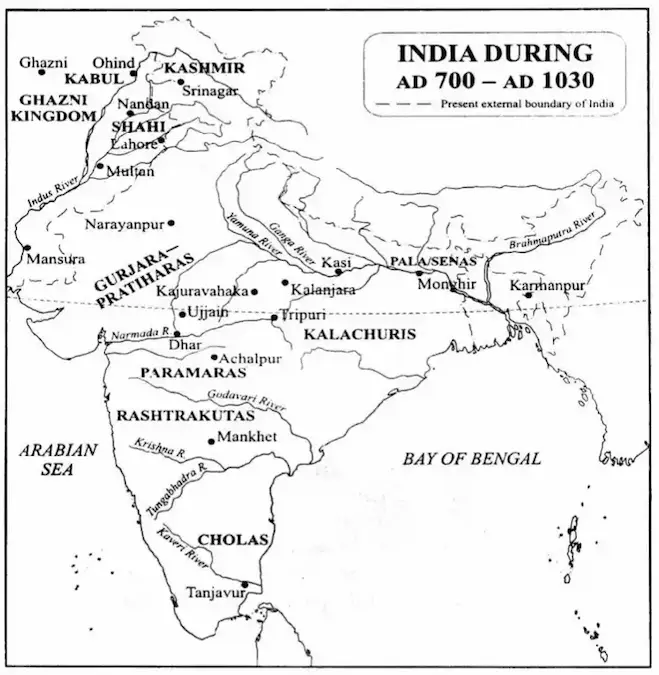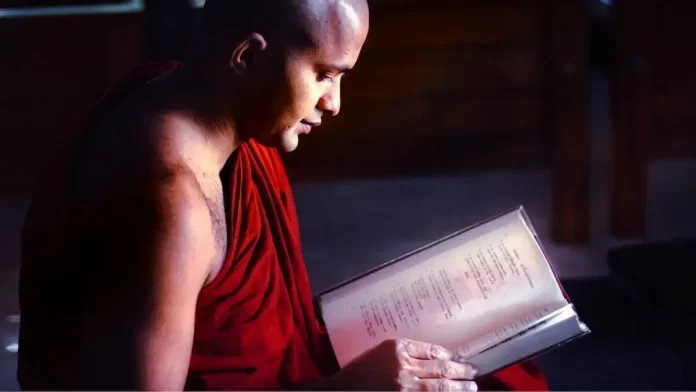The Pala Dynasty or Pala Empire was founded by Gopala in 750 AD. It dominated eastern India and Bengal India between 700-1300 AD.
They were the contemporaries of the Gurjara-Pratihara and Rashtrakutas in India, the Abbasid Caliphate in the west, and the Srivajaya Empire in the East.
Pala rulers patronized Buddhism and built great monasteries and seats of Buddhist learning like Nalanda and Vikramshila.
However, they also engaged in bloody battles with the Gurjara-Pratihara rulers of Kannauj for the over-lordship of Gangetic Plains.
According to an inscription at Badal, the Palas claimed to have “eradicated the race of the Utkalas, humbled the pride of the Hunas and scattered the conceit of the Dravidas and Pratiharas“.
Read this article to learn more about the Pala dynasty and the empire it established over Eastern India and Bengal.
Pala Dynasty Origins
The Pala dynasty was founded by Gopala in 750 AD when notable people of Gaud, Bengal elected him their ruler to end the lawlessness prevailing there after the fall of the Gupta Empire.
There are conflicting opinions about the class and caste background of Gopala.
While some sources give him a Kshatriya status, Buddhist sources like Manjushri-Mulakalpa point to a humble Shudra origin. Ain-e-Akbari of Abul-Fazl, brands Palas as Kayasthas.
According to noted historian Satish Chandra, however, Gopala was probably a local chieftain. We are told his father was a soldier named Vapyata.
Notwithstanding their origins, the Pala dynasty rose to prominence under Gopala and his able successors.

Important Rulers
The Pala dynasty produced many able rulers who provided stability to Bengal and extended its frontiers far and wide.
Gopala
Gopala was the founder and first ruler of the Pala dynasty. He ended the anarchy prevailing in Bengal which brought much relief to the mercantile community.
Dharmapala
He succeeded his father Gopala in 770 AD. He fought with Gurjara-Pratiharas for the control of Kannauj.
Devapala
He was the son of Dharmapala and ruled for 40 years. He extended the frontiers of the Pala Empire to Assam, Orissa, and parts of Nepal.
Administration
The administrative apparatus of the Pala empire was largely modeled on Gupta Empire.
The Pala Kings possessed absolute powers and also claimed divinity with titles like Parameshwara (God), Paramvattaraka, and Maharajadhiraja, etc.
For administrative convenience, the Empire was divided into several provinces called Bhuktis which were further sub-divided into Divisions called Vishayas.
The Divisions were divided into Districts called Mandalas.
Important Administrative Posts in Pala Empire
Copperplate inscriptions mention the following administrative posts in the Pala Imperial Service-
| Administrative Posts |
|---|
| Raja (The King) |
| Samanta and Mahasamanta (Vassal kings) |
| Vishayapati |
| Ranaka (Subordinate chiefs) |
| Mahasandhi-vigrahika (Foreign minister) |
| Duta (Head Ambassador) |
| Rajasthaniya (Deputy) |
| Aggaraksa (Chief guard) |
| Sasthadhikrta (Tax collector) |
| Chauroddharanika (Police tax) |
| Shaulkaka (Trade tax) |
| Dashaparadhika (Collector of penalties) |
| Tarika (Toll collector for river crossings) |
| Mahaksapatalika (Accountant) |
| Jyesthakayastha (Dealing documents) |
| Ksetrapa (Head of land use division) |
| Pramatr (Head of land measurements) |
| Mahadandanayaka or Dharmadhikara (Chief justice) |
| Dandashakti (Police forces) |
| Khola (Secret service) |
| Gavadhakshya (Head of dairy farms) |
| Chhagadhyakshya (Head of goat farms) |
| Meshadyakshya (Head of sheep farms) |
| Mahishadyakshya (Head of Buffalo farms) |
Significant Events
Some of the significant events that took place during the rule of the Pala Dynasty include the capture of Kannauj by Dharmapala, his defeat at Monger, and mercantile and trade relations with foreign states, etc.
Capture of Kannauj
Pala ruler Dharmapala captured the Pratihara capital Kannauj and held a grand Durbar. We are told that several rulers of Punjab and Rajasthan attended it and acknowledged his suzerainty.
Defeat at Monger
After the loss of Kannauj, the Gurjara-Pratiharas regrouped themselves under Nagbhatta and took back their lost territories. Further, Nagbhatta inflicted a crushing defeat to Dharmapala near Monger, Bihar.
Revival under Devapala
After the defeat at the hands of Nagbhatta, the Pala power revived under Devapala who extended his frontiers to Assam, Nepal, and Orissa.
Mercantile and Intellectual Exchanges
The Pala Empire of Bengal had mercantile and intellectual contacts with notable foreign powers like Abbasid Caliphate, Srivijaya Empire, Tibbet, etc.
It was during the Pala rule that the famous Bait-ul-Hikmah or the House of Wisdom in Baghdad recognized the mathematical and astronomical achievements of Indians.
Abbasid coins discovered in archaeological sites of Bengal attest to flourishing trade between Bengal and the Caliphate.
The Pala empire exchanged embassies with the Srivijaya and Sailendra Empires which ruled over large parts of Malaysia and Indonesia.
Sailendra Empire also sought permission from Devapala to build a Buddhist monastery at Nalanda which he willingly gave and also set aside the revenue of 5 villages for its upkeep.
Important Personalities
In addition to rulers, the Pala Dynasty also reminds us of some important personalities of those times.
Sulaiman
He was an Arab merchant who visited the Pala Empire and has left exaggerated accounts of the Pala dynasty.
According to him, the Pala rulers were accompanied by a force consisting of 50000 war elephants. Another Arab philosopher and historian Ibn Khaldun mentions the number of elephants as 5,000.
Sangharakshita and Dipankara (Atisa)
They were famous Buddhist scholars in the Pala Empire who went to Tibet and introduced a novel form of Buddhism there.
Art and Culture
Rulers of the Pala dynasty were patrons of art and culture. They religiously followed the Mahayana and Tantric schools of Buddhism but were tolerant of other religions as well.
Buddhist Monasteries
Pala rulers constructed some of the historic Buddhist monasteries and Viharas of India. These include the Odantapuri monastery in Bihar and Somapura Mahavihara in Bangladesh.
Buddhists Monks from India and other nationalities lived there. Needless to say, Buddhism thrived under the rule of the Pala dynasty.
Pala dynasty also happens to be the last major ruling dynasty in India under which Buddhism received state support patronage.
After the fall of the Pala dynasty, Buddhism also rapidly declined in India was replaced by Hindu-Brahmanism.
Nalanda and other World Famous Universities
Pala rulers also established many renowned Universities and Buddhist places of learning.
For instance, King Dharmapala revived the great Nalanda University in Bihar, one of the magnificent seats of learning in the East.
Dharmapala also laid the foundation of Vikrahmshila university, also located in the Magadha region of Bihar.
Students, Scholars, and Monks from Tibet and China thronged these Universities and enriched Buddhism in their native countries.
Besides Buddhism, Pala rulers also gave hefty land grants to Hindu-Brahmin institutions. By doing so they continued the tradition of Satavahanas and Gupta rulers.
Positive Sides
The positive sides of the Pala rule in East India include-
- Rulers of Pala dynasty had humble origins.
- Pala Dynasty Ended lawlessness and anarchy in Bengal which helped in the growth of trade and commerce.
- They Patronised education, art, and culture.
- Founded many universities and places of learning in East India even though they were restrcited to some foreigners and upper castes.
- Established contacts and exchanged embassies with foreign rulers.
- Promoted merchantile trade and commerce.
Negative Sides
Some negative aspects of the Pala rule in East India include-
- Engaged in constant warfare with Gurjara-Pratiharas which drained state resources.
- Pala rulers Invaded and devasted prosperous cities of Gangetic Plains.
- Rulers of the Pala dynasty gave large land grants to Brahmins who in turn perpetuated caste injustices in Bengal and East India.
- Famous Universities like Nalanda and Vikramshila were niches for the upper classes and some foreigners only. Common people, shudras, untouchables, and lower caste Indians were not admitted there.
- Forced pastoralists to adopt a sedentary life.
- Claimed divinity with titles like Parameshwara and promoted feudalism in Bengal.
Sources
- Satish Chandra – History of Medieval India 2018
- Pramode Lal – The Early History of Bengal 1939
- André Wink – Al-Hind, the Making of the Indo-Islamic World 1990
- Pala Empire – Wikipedia
